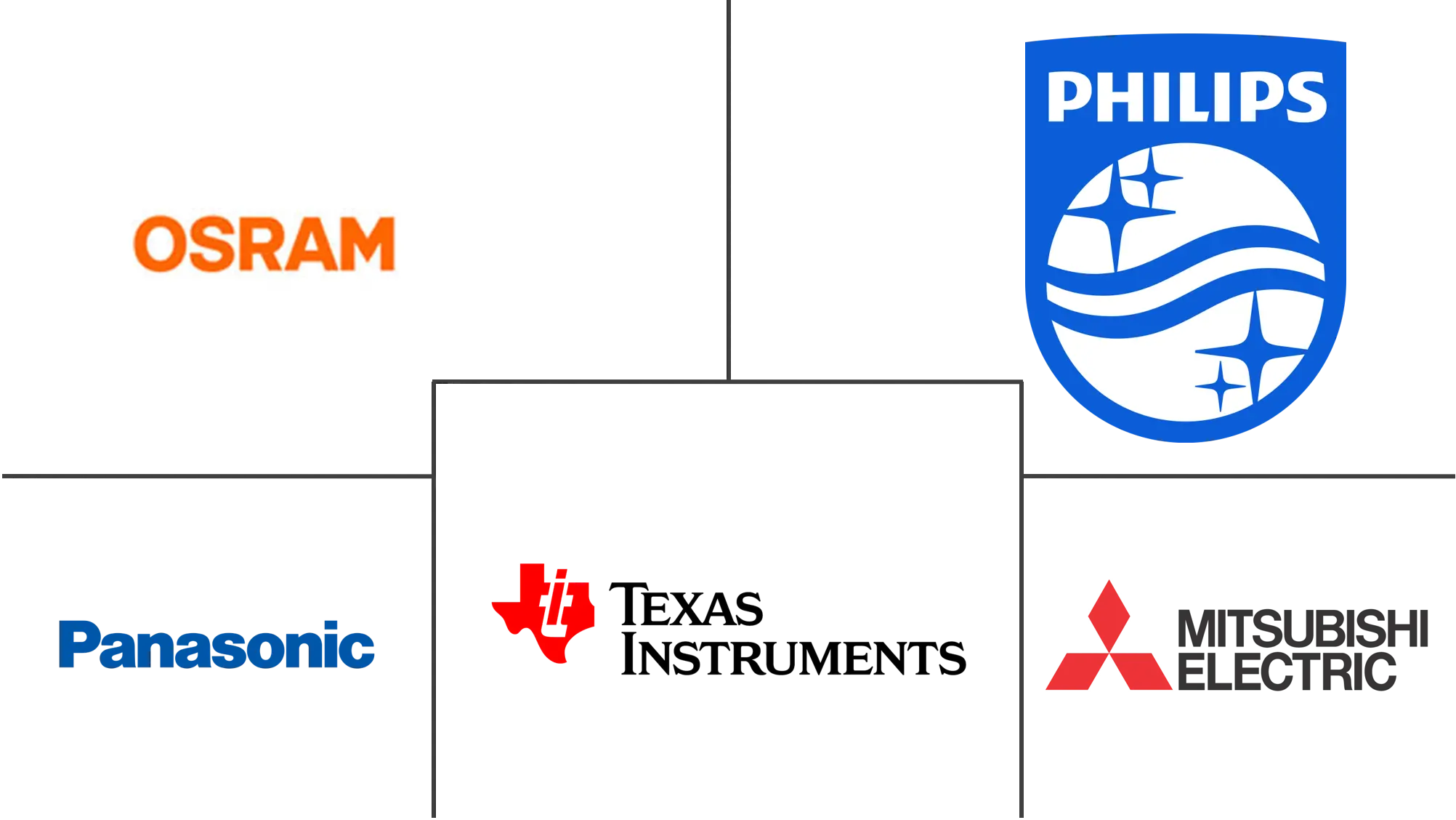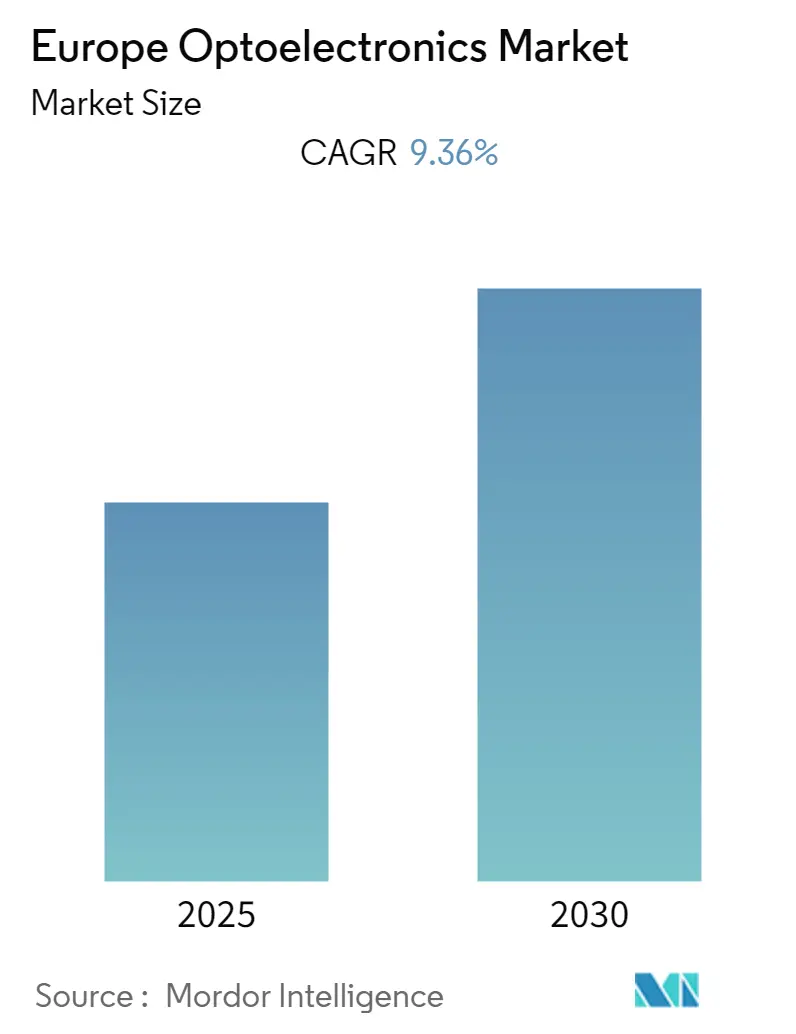
Europe Optoelectronics Market Analysis by Mordor Intelligence
The Europe Optoelectronics Market is expected to register a CAGR of 9.36% during the forecast period.
- The increasing involvement of regional government in promoter search programs has enhanced many semiconductors-oriented industries, and it is supported by high technology connectivity environment. For instance, the German Government is committed to increasing the number of research companies to 20,000 and innovative companies to 140,000 by the year 2020.
- According to Germany Trade & Invest, Germany's electronics, and electrical companies manufacture more than 100 thousand different electronic products and systems, ranging from automation systems, electronic medical equipment, automotive electronics, and microelectronic components.
- In the automotive industry, OEMs have been focusing on developing the next generation of electrified, autonomous vehicles. The United Kingdom is encouraging the adoption of autonomous cars. The UK government also funded GBP 100 million to the UK Connected Intelligence Transport Environment(UKCITE), a project that aims to create an advanced environment for testing autonomous and connected vehicles, which include technologies, such as emergency vehicle warning(EVW), road works warning(RWW), emergency electronic brake light(EEBL), and traffic condition warning(TCW).
- Furthermore, the United Kingdom is the leading destination for foreign direct investment into the European Union, with a growing proportion coming in high technology sectors. With the significant expertise in design and manufacturing, combined with policy and a business-friendly environment, the United Kingdom lighting industry offer significant investment opportunities to businesses through collaboration and direct investment.
- The outbreak of COVID-19 affected the production facilities of automotive industries across the globe. COVID-19 outbreak in European countries affected the automobile industry in the region. Spain, Russia,United Kingdom, Italy, France, and Germany is the worst-affected country after the UnitedStates, and the unprecedented lockdown of the country has heaped fresh pressure on thee region's ailing car sector.
Europe Optoelectronics Market Trends and Insights
Automobile Industry to Drive the Market Growth
- The improving global economic conditions, changing lifestyle, rising middle class, and increase in the disposable income of the consumers have increased the demands of sales of luxury and ultra-luxury cars across the globe. In a vehicle, optoelectronics devices can be used for occupant detection, drowsy driver detection, night vision, optical immobilizer, and remote keyless entry.
- Optoelectronics are increasingly being used in automobiles to automate vehicle functions such as lighting and brakes. Furthermore, optoelectronic is gradually being included in vehicle safety systems such as night vision systems, which use active or passive infrared systems to improve the distance a driver can see beyond the reach of headlights or in hazardous driving circumstances.
- Vehicle buyers' primary concern is the safety of the passengers and the vehicle. The goal of regulatory authorities all around the world is to increase automobile safety. Because of raising public awareness of vehicle safety and government demands for safety features, Optoelectronics is now offering a variety of safety features as standard equipment in automobiles. BMW Adaptive Headlights, Mercedes Multibeam LED headlights are one of the best headlights available in the automobile industry, this improves the display and visibility on road, thus making the vehicle more secure and safer for the passengers.
- The Automotive Optoelectronic market is expected to benefit considerably from the adoption of LEDs. They're utilised for things like brake lights, puddle lights, hazard lights, and warning lights, among other things. Growing automotive manufacturing around the world is one of the reasons driving the global Automotive Optoelectronic market forward. Furthermore, rising demand for luxury cars in developing nations such as Brazil, China, and India would propel market expansion.
- According to the world semiconductor Trade Statistics In 2020, revenue from the sale of semiconductors in Europe reached 37.52 billion U.S. dollars, with forecasts projecting it will rise to 45.45 billion U.S. dollars in 2021.
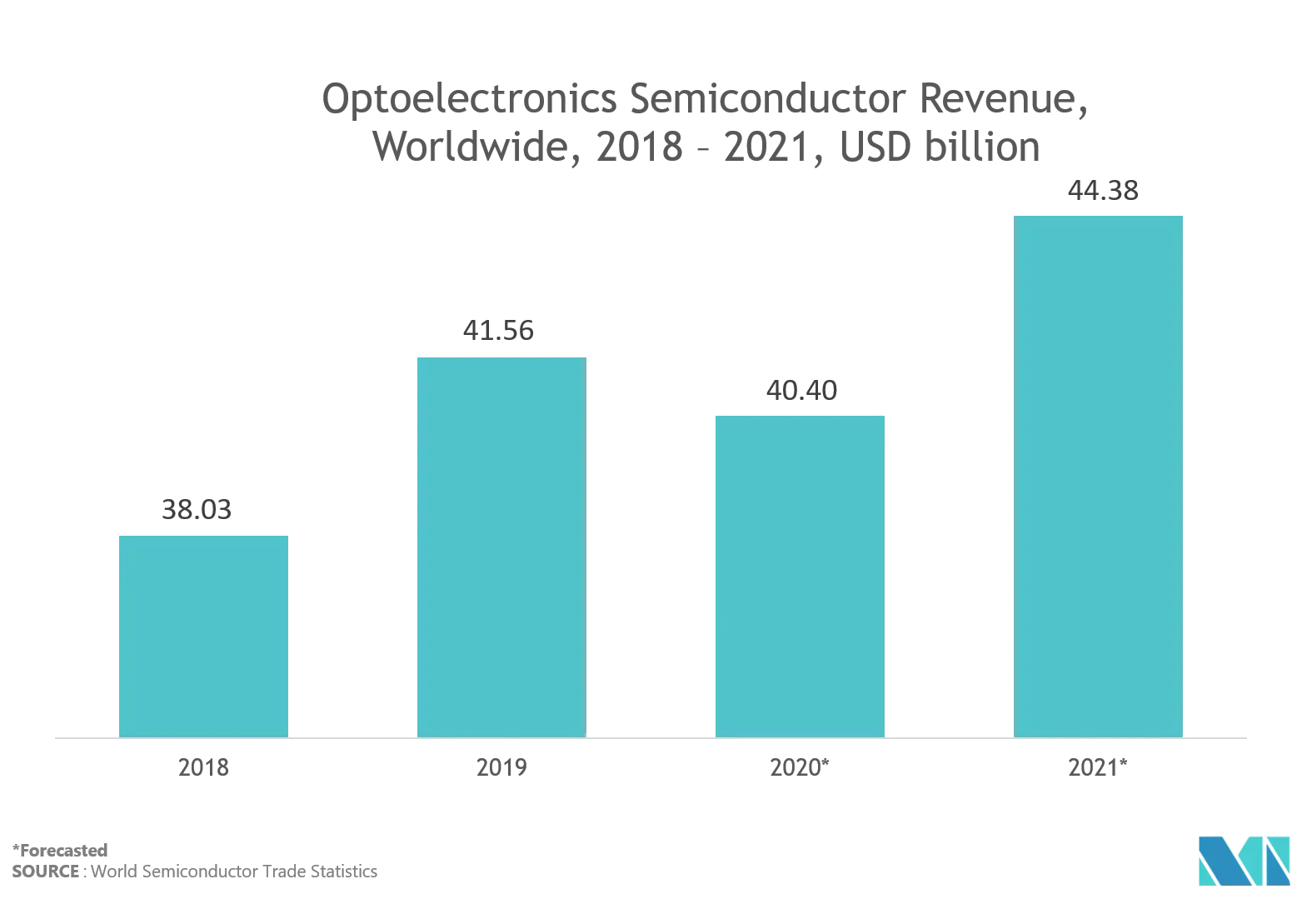
LED Industry to drive the Market Growth
- Europe is one of the most lucrative regions for the LED demand and is expected to maintain the demand over the forecast period. This is a reflection of stringent government regulations such as energy performance contracting(EPC) in countries such as Germany, Italy, and France, among others.
- Industrial Research funding is one of the major reasons why Germany has so many advanced and cutting edge products let it be any field. The massive spending by the German government is one of the prominent features that fuels up the research culture in Germany. However, the German private sector is the main investor when it comes to looking for new methods, products, and applications. The Research culture and subsidies and funds by the government fuel the Optoelectronics Research needs also. Therefore, with more than 500 companies in the field of optical technologies, Bavaria is the number one location in Germany.
- Germany has been experiencing growth in demand for LED lighting solutions both for residential and commercial applications due to change in European Union regulations related to lighting. In 2018, European Union banned the use of less efficient light, halogen light bulbs, as a part of the final stage of the European Union energy rules directive (EC244/2009) with the aim of improving energy efficiency and cutting the carbon footprint across the region.
- Since 2011, Germany's photonics industry has been growing every year. there are around 20 medium sized, local manufacturing company in Germany that are manufacturing Optoelectronics components and products. They cater a variety of industries such as precision tools, optical inspection systems, laser technology, measurement and control technology, aerospace, medical technology, etc. both locally and International.
- Key international players such as Ficosa subsidiary Adasens Automotive, Agfa-Gevaert HealthCare, Sill Optik, Osram Opto Semiconductors, Menlo Systems and Toptica Photonics all have sites in Germany. The regional focus areas for optical technologies are Munich-Augsburg, Erlangen-Nuremberg and Regensburg.
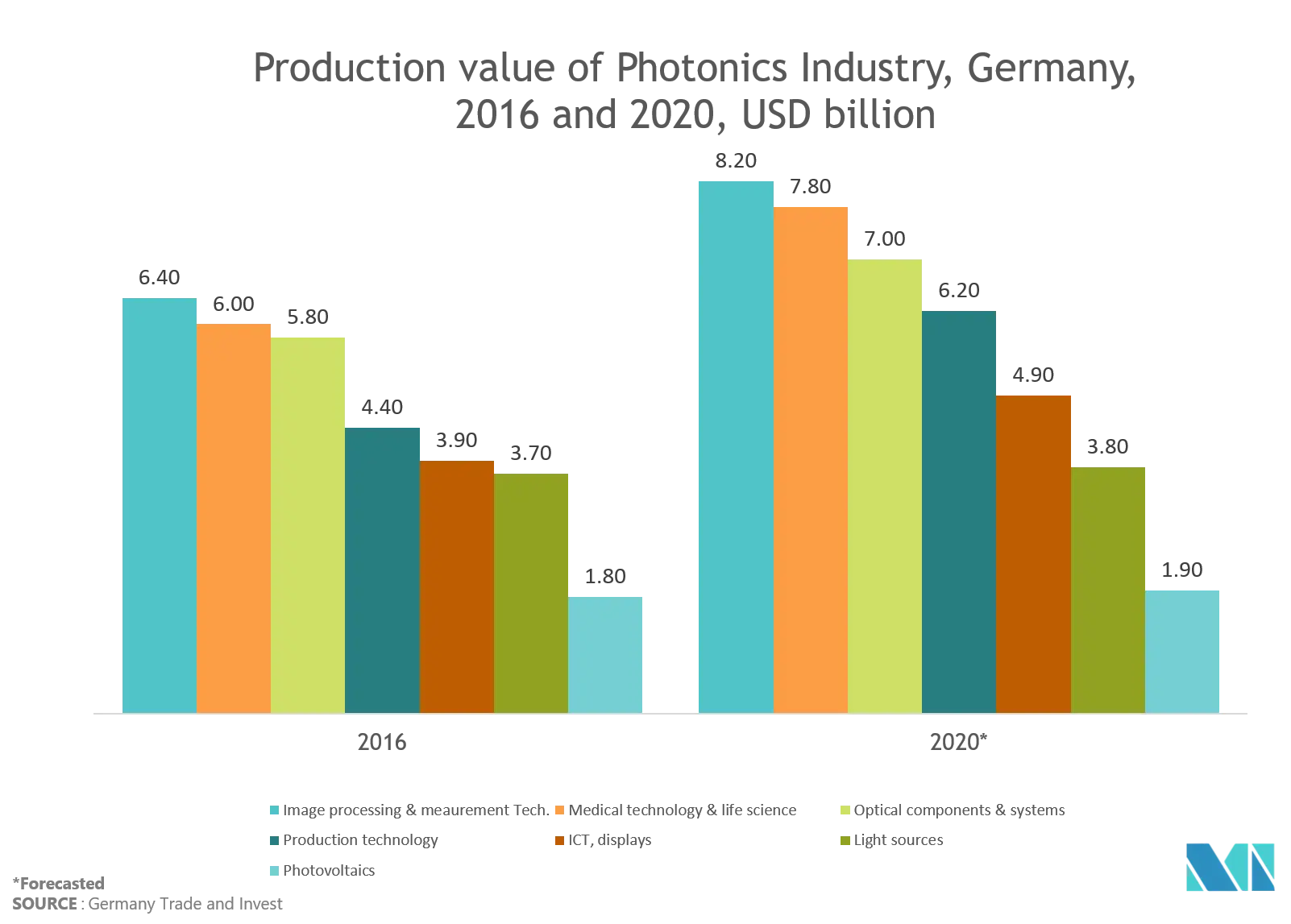
Competitive Landscape
The competitive rivalry in the optoelectronics market is high owing to the presence of major players like Osram Licht AG, Koninklijke Philips NV, Panasonic Corporation, Texas Instruments Inc., Stanley Electric Co., and many more. Strategic partnerships and mergers and acquisitions have allowed the companies to grow and gain a substantial amount of market share and maintaining a strong foothold in the market.
- July 2021- Volpi, one of the prominent players in optoelectronics with operations in the United States and Switzerland, has partnered with Netherlands-based TOPIC Embedded Systems to expand its portfolio of optoelectronic measurement solutions and further advance its digital initiatives. Product development is already underway and Volpi and TOPIC are actively collaborating on the client engagements.
- February 2021 - Toshiba Electronics Europe GmbH announced a new addition to its expansive optoelectronics portfolio. The TLP241 Bisahigh-current Photorelay, targeted at use in industrial equipment, such as programmable logic controllers(PLCs) and I/O interfaces, as well as building automation systems like HVAC(heating,ventilation,andairconditioning).
Europe Optoelectronics Industry Leaders
-
Osram Licht AG
-
Koninklijke Philips NV
-
Panasonic Corporation
-
Texas Instruments Inc.
-
Mitsubishi Electric
- *Disclaimer: Major Players sorted in no particular order
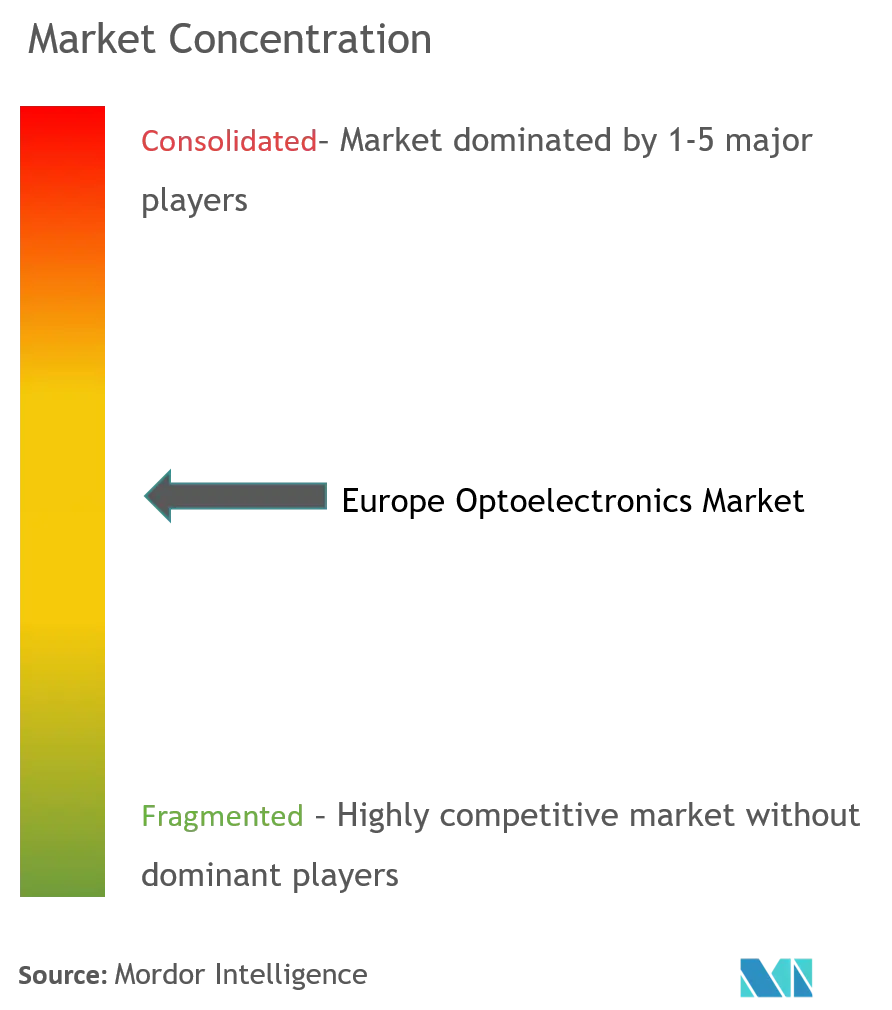
Europe Optoelectronics Market Report Scope
Optoelectronics allows communication between the optics and the electronics that includes designing, studying, and manufacturing a hardware device that converts electrical energy into light energy and light into energy through semiconductors. Optoelectronic devices find their applications in telecommunication laser, blue laser, optical fiber, LED traffic lights, photodiodes, and solar cells. The Europe Optoelectronics Market is segmented by Component type (LED, Laser Diode, Image Sensors, Optocouplers, Photovoltaic Cells), End-User Industry (Automotive, Aerospace, and Defense, Consumer Electronics, Information Technology, Healthcare, Residential and Commercial, Industrial) and Country.
| LED |
| Laser Diode |
| Image Sensors |
| Optocouplers |
| Photovoltaic Cells |
| Other Component Types |
| Automotive |
| Aerospace and Defense |
| Consumer Electronics |
| Information Technology |
| Healthcare |
| Residential and Commercial |
| Industrial |
| Other End-user Industries |
| United Kingdom |
| Germany |
| France |
| Italy |
| Rest of Other Countries |
| By Component type | LED |
| Laser Diode | |
| Image Sensors | |
| Optocouplers | |
| Photovoltaic Cells | |
| Other Component Types | |
| By End-user Industry | Automotive |
| Aerospace and Defense | |
| Consumer Electronics | |
| Information Technology | |
| Healthcare | |
| Residential and Commercial | |
| Industrial | |
| Other End-user Industries | |
| By Country | United Kingdom |
| Germany | |
| France | |
| Italy | |
| Rest of Other Countries |
Key Questions Answered in the Report
What is the current Europe Optoelectronics Market size?
The Europe Optoelectronics Market is projected to register a CAGR of 9.36% during the forecast period (2025-2030)
Who are the key players in Europe Optoelectronics Market?
Osram Licht AG, Koninklijke Philips NV, Panasonic Corporation, Texas Instruments Inc. and Mitsubishi Electric are the major companies operating in the Europe Optoelectronics Market.
What years does this Europe Optoelectronics Market cover?
The report covers the Europe Optoelectronics Market historical market size for years: 2019, 2020, 2021, 2022, 2023 and 2024. The report also forecasts the Europe Optoelectronics Market size for years: 2025, 2026, 2027, 2028, 2029 and 2030.
Page last updated on:
Europe Optoelectronics Market Report
Statistics for the 2025 Europe Optoelectronics market share, size and revenue growth rate, created by Mordor Intelligence™ Industry Reports. Europe Optoelectronics analysis includes a market forecast outlook for 2025 to 2030 and historical overview. Get a sample of this industry analysis as a free report PDF download.
